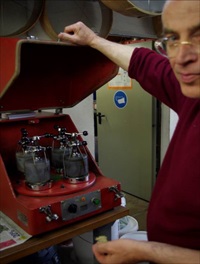Members Login

Channels
Special Offers & Promotions
Pigment processing: The isolation of the naturally beautiful
The primary particle in the perception of the visible range
 Mankind has always enjoyed enduring works of art. The particles of the pigments have always been playing a major role. For example, the oldest cave paintings still impress us today. One of the most renowned experts for the production of historical pigments is Dr. Kremer from Aichstetten (Bavaria, Germany). FRITSCH laboratory mills are of great importance in Dr. Kremer’s pigment processing.
Mankind has always enjoyed enduring works of art. The particles of the pigments have always been playing a major role. For example, the oldest cave paintings still impress us today. One of the most renowned experts for the production of historical pigments is Dr. Kremer from Aichstetten (Bavaria, Germany). FRITSCH laboratory mills are of great importance in Dr. Kremer’s pigment processing.
Kremer’s wide product range
The 1977 founded company is managed by chemist Dr. Georg Kremer. The core of the business is the preparation of pigments according to ancient formulations. By comminution of the raw materials like for example minerals or plants, which are required by the recipe, the pigment is identically reproduced. The experience and reports of the users have shown, that the synthetic alternatives do not come even close to the quality of the original formulations. Therefor customers gladly use Kremer’s supply of pigments. Kremer’s customer base consists of artists and restorers from around the world.
The ideal pigment particle
A pigment which is being comminuted has an altered
color, in contrast to the primary particle. This is due to the fact, that crystals because of their size, influence the transparency. The primary particle is therefore responsible of how we optically perceive it. Shown in the photo on the right, the intensity decreases towards the left – to the finer particles; therefore the finest share seems to be the lightest. The shares are: < 63 µm, 63 – 80 µm, 80 – 100 µm, 100 – 125 µm, 125 – 200 µm. But not only is the size essential for the perception of the particles, but especially its shape. Ideally, the particle is absolutely round. This is from an energetic viewpoint absolutely necessary in order to reflect the light as well as possible. Edges on the surface of the particle would not diffract the light exactly and the perception would change in regards to the angular dependence. Additionally, is it of great advantage for the user since the round equally large particles can be applied and distributed in an exact manner. When using a brush or other tool for the application, the tool will not get damaged if the particles are round and do not have sharp edges. Like demonstrated in the photo, the ensuing fractioning plays an important part. Because the ideal particle is not only round, but ideally are all particles the same size. In order to achieve this, the fractioning is performed with a FRITSCH Sieve Shaker.
Comminution of pigments
At Kremer’s pigments, various FRITSCH laboratory mills are utilized. The Jaw Crusher PULVERISETTE 1 is used for the coarse pre-comminution, large amounts can be excellently continuously ground. For the additional processing, is the Disk Mill PULVERISETTE 13 the suitable instrument. The material characteristics of the sample decisively influence the choice of the comminution method. For brittle or fibrous materials the staff of Kremer’s pigments has the Variable-Speed Rotor Mill PULVERISETTE 14 available. Here the rotor precisely comminutes the rough pieces and only discharges the suitable share through the sieve into the collection vessel. But also the Mortar Grinder PULVERISETTE 2, as well the Planetary Mill PULVERISETTE 5 are used. The Heavy Duty Analytical Sieve Shaker ANALYSETTE 18 is utilized for the subsequent fractioning. The essence of pigment processing with the FRITSCH Planetary Ball Mill is that the particles obtain a softer almost round shape through the circulation inside the grinding bowl and the mechanical strain of the round grinding bodies.
Of course it would be ideal if the desired grain size distribution of the particles could be very closely together. Very often the production of pigments of a certain fractions is requested. For this reason the grinding parameters at Kremer’s were optimized in order to avoid the production of too many large or fine shares and producing as much as possible of the desired fraction.
Media Partners


